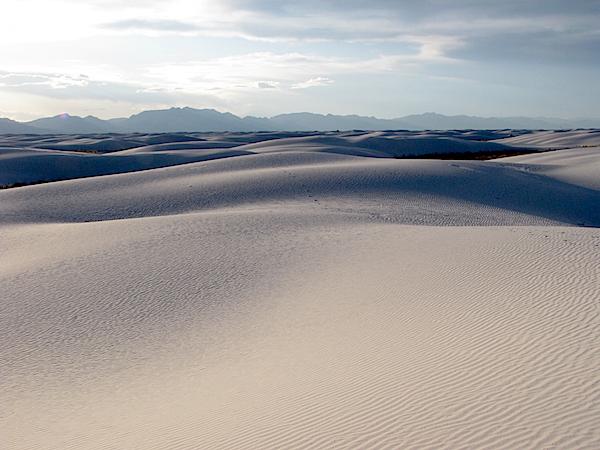
A mesmerizing spring trip awaits at White Sand Dunes National Monument/NPS
Find yourself deep in the Southwest in spring and you'll enjoy the mild weather, perfect for this trio of parks.
White Sands National Monument is 275 square miles of unique dunes of bright white sand. Just 15 miles from Alamogordo, New Mexico, these great, wave-like dunes aren't even true sand dunes at all. They are actually the largest surface deposit of the mineral gypsum on Earth, left here by the wind. And, because they reflect the sunlight, they're actually cool to the touch and home to many species of birds and mammals.
Take an early morning, or late afternoon, jaunt down Dunes Drive once you enter the park for a 16-mile roundtrip into their heart. You may see lizards and snakes, fox and badgers, mountain lion and bobcat amid the 50-foot-tall dunes; they're easy to spot against the white background. Wear some good boots, take a gallon of water, and explore this other-worldly park. 'There are no words...you just have to experience this place,' said one visitor.
Then, head east. Drive over the forested peaks through the mountain town of Cloudcroft towards Carlsbad Caverns National Park, just three hours away. Beneath the Guadalupe Mountains' thorny desert lays an unimaginable, underground world. There are more than 100 caves, carved by sulfuric acid-rich water through the fossilized, prehistoric limestone.
Carlsbad Cavern is the largest and most-visited of these. Take a self-guided tour along paved, lighted trails through the Big Room, along the Natural Entrance route, or enhance your trip with a ranger-guided trip from room to room, where it's always cool, even on the hottest day. You'll see how water and calcium carbonate, dripping through the rock, have created a fairyland of stalagmites, helictites, popcorn, and soda straws. Don't miss the Witch's Finger, a natural column from floor to ceiling.
Above ground again, take the seven-mile Walnut Canyon scenic drive, where you can hike and look for animals and birds.
Just a half-hour south, Guadalupe Mountains National Park rises nearly 9,000 feet, making its roof the highest point in Texas. The mountains are a fossilized reef from the Permian Era that today holds wooded canyons and lush springs. At the Pine Springs Visitor Center you can plan your extended visit, or take the Pinery Trail out the back door where you'll be introduced to the native plants, and see the ruins of the old stage station of the Butterfield Overland Mail.



Add comment